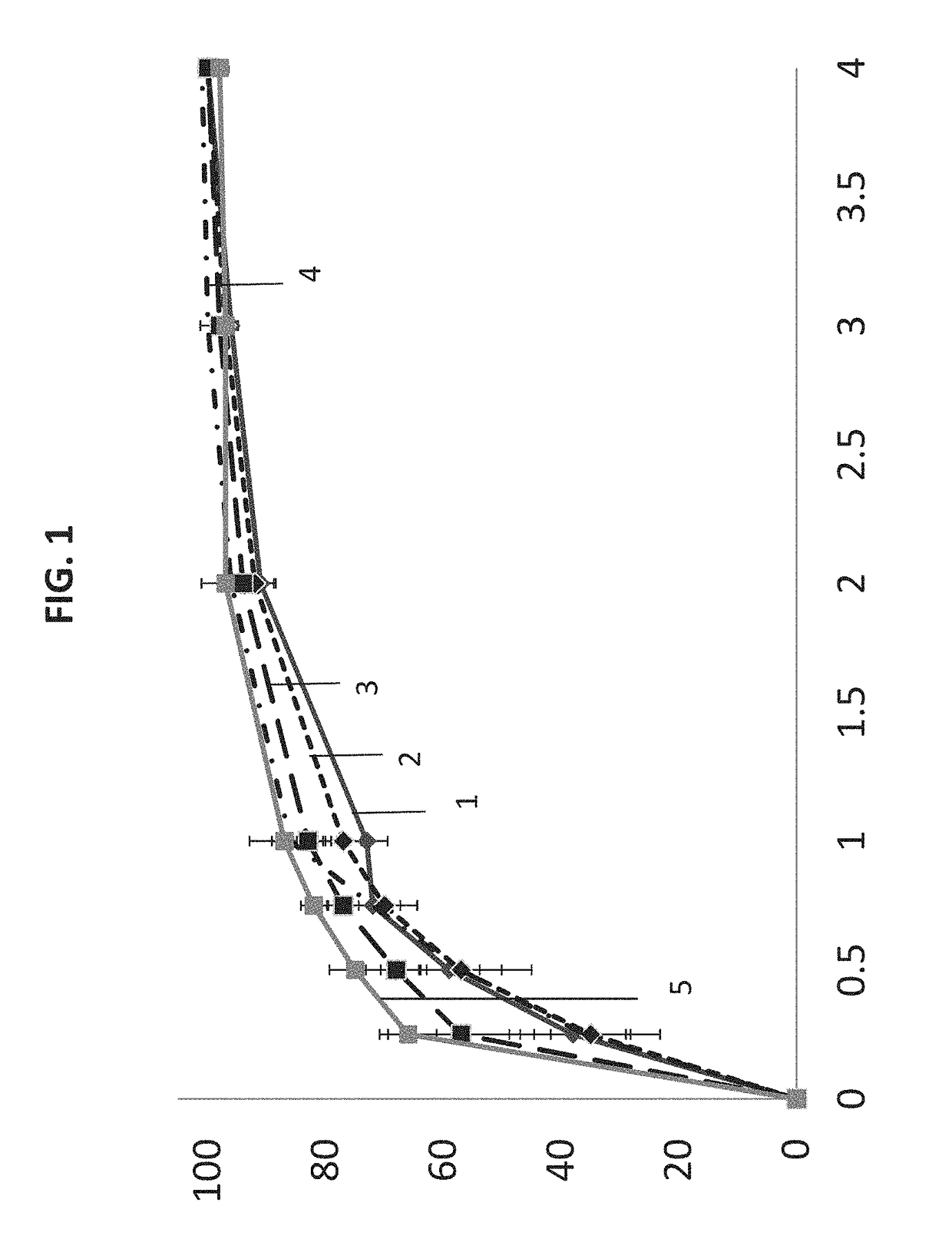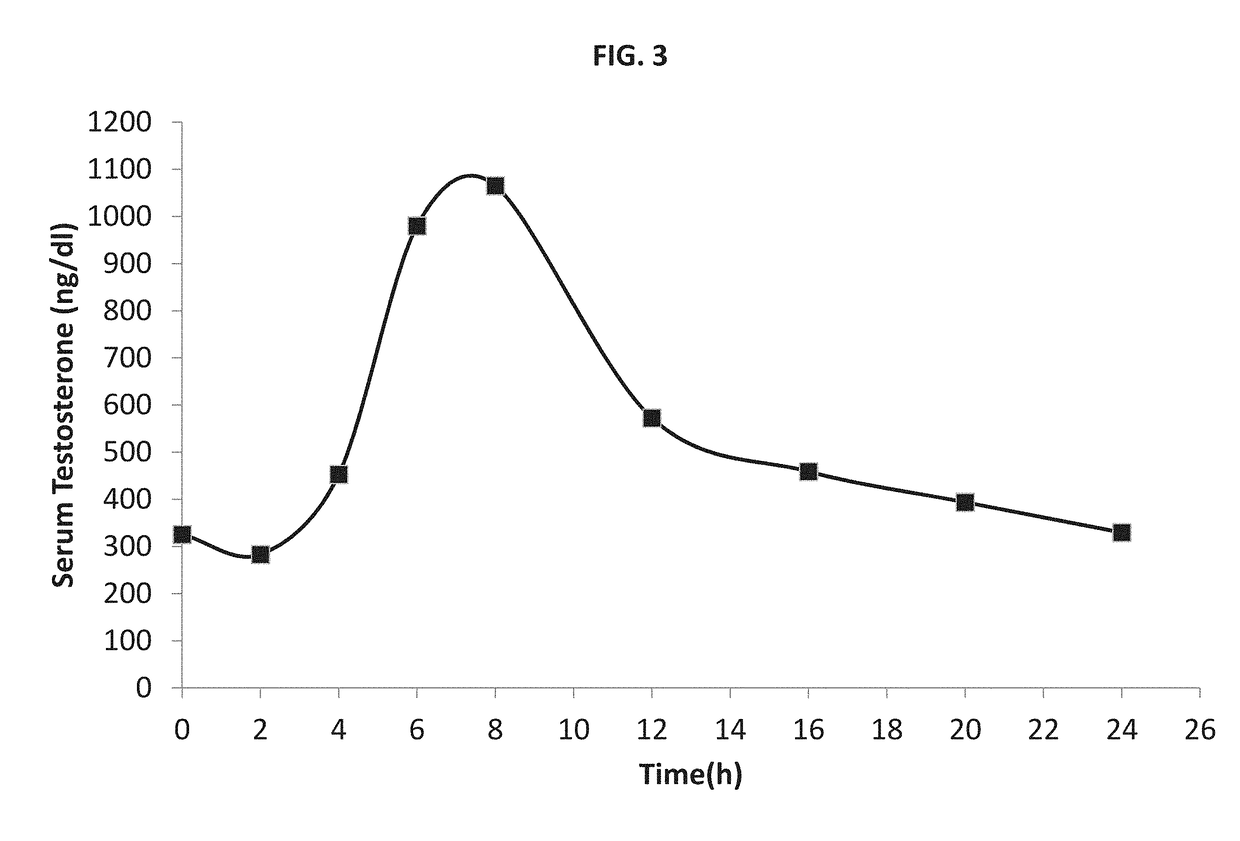Pharmaceutical composition and methods
a technology of pharmaceutical composition and method, applied in the field of pharmaceutical industry, can solve the problems of difficult to exert the therapeutic effect of difficult to obtain drugs having a high log p, and difficulty in developing a unit dosage form that facilitates the transit of active agents into (e.g., systemic or lymphatic) circulation, etc., and achieve excellent bioavailability of testosterone. , the effect of adequate bioavailability
- Summary
- Abstract
- Description
- Claims
- Application Information
AI Technical Summary
Benefits of technology
Problems solved by technology
Method used
Image
Examples
##s embodiments
Exemplary Formulations Embodiments
[0069]Provided in this section are formulations.
TABLE 1Drug + CarriersCompositions (w / w %)Ratio of API:Carrier inTestosteronea pharmaceuticalCompositiontridecanoate*CarriercompositionA10-1585-901:5.7-1:9.0B15-2080-851:4.0-1:5.7C20-3070-801:2.3-1:4.0D30-4060-701:1.5-1:2.3E40-5050-601:1.0-1:1.5*As an active ingredient, it can be untreated, sieved (PS
TABLE 2Carrier ComponentsCarrier No.ComponentIIIIIIIVVVIVIIVIIIIXXXIXIIXIIISolubi-PropyleneY————————————lizerglycol monoor di-lauratePropylene—Y———————————glycol monoor di-caprylateCorn——Y——————————glycerides(e.g. Glycerylmono or di-linoleate)Vegetable———Y—————————glycerides(e.g. Glycerylmono or di-oleate)Glyceryl mono————Y————————or di-stearateGlyceryl—————Y———————palmito-stearate(9Z)-Octadec-——————Y——————9-enoic acidOctadecanoic———————Y—————acid(9Z,12Z)-9,12-————————Y————Octa-decadienoicacidPeppermint oil—————————Y———Omega-3——————————Y——EPA / DHAVitamin E———————————Y—Combinations *————————————YHydro-Cremo...
example 1
y in Some Pharmaceutically Acceptable Carriers / Excipients
[0091]The solubility of (8R,9S,10R,13S,14S,17S)-10,13-dimethyl-3-oxo-1,2,6,7,8,9,11,12,14,15,16,17-dodecahydrocyclopenta[a]phenanthren-17-yl tridecanoate was determined in the solvents (typical pharmaceutical carriers) listed below.
SolventSolubility mg / g at ~20-23° C.Corn glycerides-Maisine77Peppermint Oil~200Medium chain glycerides-Capmul68Benzyl Benzoate223Benzyl Alcohol322Ethanol27Cremophor RH4010Corn oil35Olive Oil38Castor Oil55
[0092]This table shows that the API described herein has solubility of greater than 5 mg / g, 20 mg / g, 50 mg / g, 75 mg / g or 100 mg / g in pharmaceutically acceptable carriers (e.g., solvents) suitable as components of oral pharmaceutical compositions. Additionally, it is believed that the API in similar carriers that are solid or semi-solid at room temperature will have similar solubility at elevated temperatures (greater than 25, 30, 35, 40, 45, 50, 60, 65, 70, 75, or 80° C.) suitable for manufacturing ...
example 2
tical Compositions
[0093]Shown below are various compositions suitable for oral administration as described herein. In these Examples the amount of excipient adds up to 100% (does not include the API) and the API weight percent is the final weight percent in the pharmaceutical composition.
Composition No.Component (w / w %)1234567API22232426283032Excipient 135-80 35-80 35-80 35-80 35-80 35-80 35-80 (e.g., liquidcarrier)Excipient 21-401-401-401-401-401-401-40(e.g., additive)Excipient 30-200-200-200-200-200-200-20(e.g., hydrophilicadditive)Excipient 40.01-3 0.01-3 0.01-3 0.01-3 0.01-3 0.01-3 0.01-3 (e.g., anti-oxidant)AdditionalqsqsqsqsqsqsqsExcipients(e.g., otherpharmaceuticallyacceptableexcipients)
[0094]The API in this example in specific compositions is (8R,9S,10R,13S,14S,17S)-10,13-dimethyl-3-oxo-1,2,6,7,8,9,11,12,14,15,16,17-dodecahydrocyclopenta[a]phenanthren-17-yl tridecanoate or (8R,9S,10R,13S,14S,17S)-10, 13-dimethyl-3-oxo-1,2,6,7,8,9,11,12,14,15,16,17-dodecahydrocy...
PUM
| Property | Measurement | Unit |
|---|---|---|
| partition coefficient | aaaaa | aaaaa |
| partition coefficient | aaaaa | aaaaa |
| temperatures | aaaaa | aaaaa |
Abstract
Description
Claims
Application Information
 Login to View More
Login to View More - R&D
- Intellectual Property
- Life Sciences
- Materials
- Tech Scout
- Unparalleled Data Quality
- Higher Quality Content
- 60% Fewer Hallucinations
Browse by: Latest US Patents, China's latest patents, Technical Efficacy Thesaurus, Application Domain, Technology Topic, Popular Technical Reports.
© 2025 PatSnap. All rights reserved.Legal|Privacy policy|Modern Slavery Act Transparency Statement|Sitemap|About US| Contact US: help@patsnap.com



